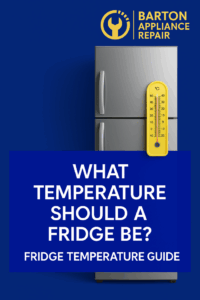In a fridge, you should know how to maintain the correct temperature. It is important for the safety of your food, energy efficiency, and reducing waste. Many homeowners ignore this important aspect of food storage, which also possibly risks their health and increases their utility bills. This guide will tell you everything about the right temperatures, explain the risks of incorrect settings and give you practical tips so that your fridge works perfectly.
Most People Get This Wrong: The Real Ideal Fridge Temperature
Experts agree: the safest and most effective fridge temperature sits right between 35 and 38 degrees Fahrenheit.
U.S. Food and Drug Administration (FDA), in their 2025 guidelines, says that fridges should be kept at or below the temperature of 40°f or 4C. It is said to prevent any type of bacterial growth. But, the food safety experts say that the colder range of 35-38F is best for protecting your food without freezing it.
This interval is so specific due to the harmful bacteria such as Listeria, Salmonella, and E. coli that rapidly multiply in the “danger zone” of 40°f and 140°f. Therefore, having your fridge in this range of temperatures will decrease the risk of foodborne diseases.
Quick Tip: Fridge dials can be misleading; use a simple thermometer to get a true read on the internal temperature.
Related: Which Is the Best Refrigerator to Buy in 2025
Why Fridge Temperature Matters?
1. Food Safety Concerns
If the temperature is not right, it will create an environment where harmful bacteria will grow. Recent 2025 studies show that even a few degrees above the suggested fridge temperature can allow Listeria to multiply quickly and poison the food. Individuals like pregnant women, older adults, and those with weaker immune systems are in greater danger from these foods.
2. Food Quality and Extended Shelf Life
The right fridge temperature slows enzymatic reactions and microbial growth. It also protects the taste, texture, and nutritional value. For example:
- Milk stored at the proper temperature will last 5-7 days longer.
- Fresh vegetables have their crispness and vitamin content up to 40% longer.
- Meats maintain their quality and safety for an additional 2-3 days.
This will make sure that the food tastes better. It also reduces food waste, a big concern in an average family.
3. Energy Efficiency and Cost Savings
When your fridge is working at the correct temperature, it uses energy more efficiently. For every degree that is colder than needed, the appliance will consume approximately 5% more energy. Also, you can’t run it too warm as it would lead to food spoilage and waste. The latest ENERGY STAR refrigerators are made to work efficiently at the recommended temperature range. This will help households save up to $100 in electricity.
Related: How to Clean Your Dryer Vent in 8 Easy Steps
Common Fridge Temperature Issues and Solutions
1. Inaccurate Thermostat Readings
Problem: Sometimes the built-in fridges can drift even by 5F from their settings.
Solution: Get a refrigerator thermometer (under $10) and keep it on the middle shelf of your main compartment. Check it regularly and adjust the settings accordingly. The latest digital thermometers can even send you alerts on your phone when the temperature fluctuates from the safe range.
2. Temperature Variations Within Your Fridge
Problem: Different areas of your appliance have different temperatures. They change up to 8°f from the coldest to warmest spots.
Solution: Know your refrigerator’s cooling patterns:
- The bottom shelves are 3-5F colder than the upper shelves.
- Door compartments can be 5-8F warmer than interior shelves.
- The rear of the shelves is usually colder than the front.
You should store items like raw meat, seafood, and dairy products in the coldest zones (the lower shelves at the back). Reserve door compartments for beverages and other less temperature-sensitive items.
3. Overcrowding Effects on Temperature
Problem: An overpacked refrigerator restricts airflow. It ends up creating warm pockets where bacteria can grow.
Solution: Keep a good amount of space between items and make sure to keep your fridge at 75-80% capacity. This helps in proper air circulation and still provides enough thermal mass to have consistent temperatures when the door is opened.
Related: 7 Laundry Tips and Hacks for Safe Washing Clothes
7 Tips for Maintaining Optimal Fridge Temperature
1. Strategic Food Placement
Organise your fridge according to temperature needs:
- Bottom shelf (coldest): Raw meat, poultry, fish
- Middle Shelves: Dairy products, eggs, cooked foods
- Upper Shelves: Ready-to-eat foods, leftovers
- Crisper Drawers: Fruits and vegetables (adjust humidity settings)
- Door Compartments (warmest): Condiments, juices, butter
2. Quick Recovery After Door Openings
Every time you open the refrigerator, the temperature rises by 10-20F. Reduce the recovery time by:
- Open doors only when it is needed
- Plan what you need before you open the door
- Organise the contents to reduce searching time
3. Seasonal Temperature Adjustments
Your fridge works harder in summer and in warmer kitchens. Make sure to adjust your temperature settings slightly colder during hot weather. Remember to monitor more frequently during extreme temperature changes.
4. Proper Food Cooling Techniques
You should not put hot food in the refrigerator as it increases the internal temperature by 10°f. This puts the surrounding food into the danger zone.
Make sure to let hot foods cool for 30-60 minutes before putting them in the refrigerator. But never leave them out for more than 2 hours.
5. Regular Maintenance Checks
- Clean condenser coils every 6 months (dirty coils can reduce efficiency by up to 25%)
- Verify and replace door seals if they are worn out
- Defrost manual-defrost freezers when ice buildup exceeds ¼ inch
6. Smart Technology Integration
The latest 2025 smart refrigerators feature:
- Precision temperature control systems
- Zone-specific cooling technology
- Mobile alerts for temperature fluctuations
- Power outage compensation systems
If you have an older model, think about adding aftermarket temperature monitors that connect to your home Wi-Fi network for the same.
7. Post-Power Outage Protocol
After power outages, check your fridge temperature. The FDA recommends removing easily spoiled food if the temperature exceeds 40°f for more than 4 hours.
Understanding Your Refrigerator’s Controls
Most fridges use numerical settings (usually 1-5 or 1-9) that sometimes don’t match specific temperatures. Generally:
- Higher numbers indicate colder temperatures
- Medium settings (3 on a 1-5 scale, 5 on a 1-9 scale) typically approximate the recommended range
For precise control, always check with a thermometer rather than depending on dial settings.
Related: Ventless Dryer Pros and Cons: What to Know Before You Buy
Conclusion: What Temperature Should Your Fridge Be At?
The right range of fridge temperature is 35- 38°f (1.7 °c- 3.3 °c). It is important for food safety, quality, and energy efficiency. You can monitor the temperature regularly, organise the contents, and maintain the appliance. This will help in increasing food freshness, preventing foodborne illness, and reducing both food and energy waste.
Take action today by checking your fridge temperature with a reliable thermometer and making adjustments as needed. This simple step can impact your family’s health and budget.
Related: How Ventless Dryers Work and Why You Might Need One





